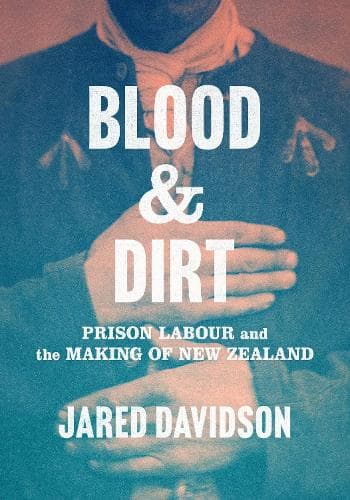Review: Blood & Dirt: Prison Labour and the Making of New Zealand
Reviewed by David Veart
During the 1870s, a wave of Russophobia swept the British Empire. In Aotearoa New Zealand, the colonial public, encouraged by the press, demanded that the government do something about defending the country’s ports from attack by the Russian navy. To help with (and possibly defer) any decision, the advice of an ‘overseas expert’ was sought and he arrived in the form of the new governor.
Sir William Drummond Jervois was a renowned authority on coastal defence and he recommended the purchase of powerful new guns while his Royal Engineer assistant Major Henry Cautley designed elaborate forts to put them in. But there was a problem. While the guns were purchased, Cautley’s designs were deemed too expensive to build and so the plans were filed, the guns put into storage and nothing happened until another Russian war scare in 1885. Quick, we need some forts!
The solution arrived in the form of a grandly named Royal Artillery officer, Edmund Meyer Tudor Boddam. Boddam had developed a cheap method of building fortifications. He used a simple modular design system, got rid of Cautley’s expensive brick and masonry and replaced them with concrete. Concrete was cheap and could be mixed, moved and poured by unskilled labour - and the cheapest form of unskilled labour was to be found in Mount Eden prison.
At Maungauika North Head on Auckland’s North Shore, the largest of the country’s forts, the new Armed Constabulary barracks was refitted as a prison and up to 40 prisoners were transferred there to provide the workforce. At the end of his commission, Boddam could report to parliament that he had completed the fortifications at about half the original budget.
The unpaid ‘unfree’ men and women who contributed to this saving are to be found in Jared Davidson’s new book on prison labour in Aotearoa New Zealand, Blood & Dirt.
There is much in this book that is familiar. I worked for 25 years for the Department of Conservation as an archaeologist and much of my time was spent in the prisoner-built places described by Davidson: at Maungauika North Head and Fort Takapuna; on Rangitoto where the roads, tracks, camp sites and even a tennis court were hewn from the unforgiving volcanic landscape by ‘unfree labour.’ In places, the prisoners’ work is clear: pick marks in tunnel walls and ceilings; the neatly stone edged roads on Rangitoto.
This book forcefully puts imprisoned human faces onto these landscapes. Davidson describes in detail the way prison labour is at the heart of much of this country’s history. Working prisoners were here from the beginning of Pākehā settlement starting in 1814 with the arrival of the brig Active and the Reverend Samuel Marsden, crew, missionaries and convict labourers from Sydney. The convicts worked at the new settlement at Hohi and then helped construct the first buildings at Waitangi.
From this start there was no looking back; prisoners quarried rock, made bricks, built roads and bridges and later created whole new landscapes by planting huge areas of exotic forest. These prisoner-planted forests add another dimension to the story. The author notes that social historians often see the environment as a setting for the human drama, here with these vast areas of trees from elsewhere, capitalism can be seen as a way of organising nature to its own ends: ‘As the state channelled seed, soil and forced labour into a national asset, it acted not only upon nature but also within and through it.’
The uses to which prison labour was put reflect changes in the rest of the economy, from the extractive early quarries and building of basic infrastructure to forestry and then to the most profitable of the prison industries, farming. Prison farms provide a good example of the many layers of our economic and social history explored by this book. This land was worked by prisoners using superphosphate mined in the Pacific by prisoners and built on lands taken under compulsory purchase from Māori. The largest area taken from Māori under the Public Works Act in the early 20th century was for a prison, 3000 acres for the Waikeria Reformatory Farm.
There is much in this book which incorporates the relationship of Māori to the prison system and prison labour. In Aotearoa New Zealand, Māori are imprisoned in greater numbers than the rest of the population, today making up 53 per cent of the prisoners from 15 per cent of the population. Davidson notes how the amount of land remaining under Māori control relates to the rate of Māori incarceration. As one falls, the other increases.
This powerful book describes yet another hidden layer in the history of these islands, a place where imprisonment, labour, punishment, class and ethnicity all combine to create a narrative at odds with any imagined story of sturdy pioneers and well earned progress. Recommended reading in a time where the urge to imprison and punish remains strong undeterred by the failure of the system to do anything but that.
Reviewed by David Veart
